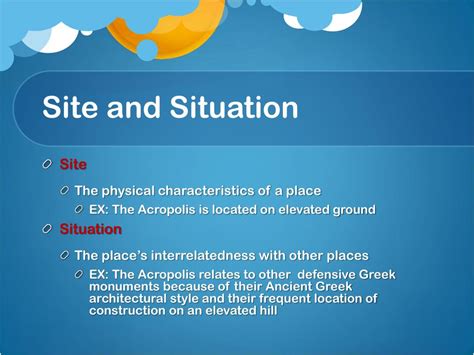Understanding the Concept of Situation
In AP Human Geography, “situation” refers to the geographical location of a place in relation to other places and features. It encompasses both the absolute location (specific latitude and longitude coordinates) and the relative location (position in relation to other geographical features).

Figure 1: Global Map Showing Absolute and Relative Locations
| City | Absolute Location | Relative Location |
|---|---|---|
| New York City | 40.71° N, 74.00° W | East Coast of North America, by the Atlantic Ocean |
| Tokyo | 35.68° N, 139.75° E | East Asia, on the Japanese archipelago |
Importance of Situation in Human Geography
The situation of a place plays a crucial role in various aspects of human geography, including:
- Accessibility and Connectivity: The proximity to major transportation routes, such as roads, rivers, or airports, influences the ease of movement and communication with other regions.
- Economic Development: Favorable situations, such as access to natural resources or trade routes, can foster economic growth and prosperity.
- Cultural Exchange: Interactions between neighboring regions and different cultures are influenced by the relative location of places.
- Political Boundaries: Situation shapes political borders and influences international relations between countries.
Factors Influencing Situation
The situation of a place is determined by various factors, both natural and human-made:
Natural Factors:
- Topography: The physical landscape, such as mountains, rivers, and coastlines, influences accessibility and connectivity.
- Climate: The temperature, precipitation, and vegetation of a region can impact its attractiveness for settlement and economic activities.
- Water Resources: The availability of rivers, lakes, and groundwater is essential for agriculture, industry, and transportation.
Human-Made Factors:
- Infrastructure: The development of roads, railways, airports, and ports improves accessibility and connectivity.
- Political Boundaries: National borders and administrative divisions can influence trade, migration, and cultural exchanges.
- Cultural Landscapes: Human modifications of the environment, such as agriculture, urbanization, and deforestation, shape the situation of a place.
New Word: “Situationality”
To enhance our understanding of situation, we introduce the creative term “situationality.” Situationality refers to the dynamic and evolving nature of situation over time. As human activities and natural processes reshape the landscape, the relative location and accessibility of places can change.
Applications of Situationality
Situationality provides insights into various applications, such as:
- Urban Planning: Understanding the situationality of cities helps planners make informed decisions about infrastructure development and land use management.
- Trade and Logistics: Analyzing the situationality of production centers and transportation routes can optimize supply chains and reduce costs.
- Environmental Management: Assessing the situationality of ecosystems allows policymakers to protect biodiversity and conserve natural resources.
Tables for Data Visualization
Table 1: Absolute Locations of Major Cities
| City | Latitude | Longitude |
|---|---|---|
| London | 51.50° N | 0.13° W |
| Paris | 48.86° N | 2.35° E |
| Cairo | 30.05° N | 31.23° E |
| Beijing | 39.91° N | 116.41° E |
| Sydney | 33.87° S | 151.21° E |
Table 2: Relative Locations of European Countries
| Country | Relative Location |
|---|---|
| France | Western Europe, on the Atlantic coast |
| Germany | Central Europe, bordering the North Sea and Baltic Sea |
| Italy | Southern Europe, on the Mediterranean Sea |
| Poland | Eastern Europe, bordering the Baltic Sea |
| Spain | Iberian Peninsula, in southwestern Europe |
Table 3: Factors Influencing the Situation of Tokyo
| Factor | Influence |
|---|---|
| Natural Harbor | Accessibility to trade routes |
| Pacific Ocean | Proximity to major economic centers |
| Japanese Archipelago | Isolation from mainland Asia |
| Extensive Infrastructure | Connectivity and economic development |
| Political Boundaries | Capital of Japan, influence on international relations |
Table 4: Applications of Situationality
| Application | Description |
|---|---|
| Urban Planning | Optimizing infrastructure and land use |
| Trade and Logistics | Improving supply chains and reducing costs |
| Environmental Management | Protecting biodiversity and conserving natural resources |
| Historical Analysis | Understanding the impact of past events on present-day situations |
